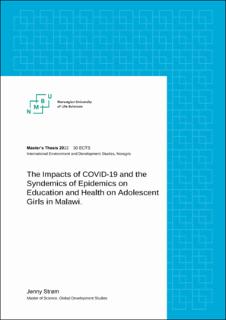| dc.description.abstract | This paper aims to address the effects the COVID-19 pandemic had on adolescent girls in Malawi, with a major focus on education and health. Furthermore, this is a comparative study, which looks at how the response to the pandemic was in comparison with the HIV and AIDS epidemic, and as such see if there are any similarities with the response. To address the research questions, qualitative methods were used in the form of in-depth interviews and analysis of primary and secondary sources. This paper concluded that there are similarities with the response and the handling of both crises. However, it is also important to point out how Malawi is a nation faced with multiple health crisis. It is also important to acknowledge that the HIV and AIDS crisis is very much an ongoing epidemic, and Malawi has still one of the highest HIV/AIDS prevalence rates in the world. Other findings are how lack ofresources, vaccine(s) inequity and limited access to treatment, medicines, and other health needs, misinformation and rumours, lack of support and proper infrastructure to address the health crisis, are all key similarities which affected the response to the crises. The study also highlights how colonisation, donor dependency, and programmes such as the Structural Adjustment Programmes, has had a detrimental impact on Malawi.
Despite Malawi having a large population within a small country, there were few breakout-cases and low mortality rates reported regarding COVID-19. This is also the case throughout Sub-Sahara Africa, except for South Africa. This has by researchers been dubbed "the SSA Covid-19 puzzle," and this puzzle has not yet been completed (Kohler et al., 2022, p. 2). Why did a region with such a large portion of the world's population only account for a small number of all global COVID-19 cases and death? Part of the answer lays in the young demographic and underreporting, but that alone cannot explain the full picture. When looking at how school closure and general lockdown impacted adolescent girls; this paper found that this greatly impacted girls' safety, education, overall health, and is a testimony to how important it is to keep girls in school. However, significant measures need to be taken to assure a quality of learning, and not just schooling, and furthermore, to provide a safe space with support without the presence of violence or harm. Schools being closed for long periods of time also caused a rise in teenage pregnancies and child marriages which makes the road back to school even more difficult, and has a significant impact on girls' overall development, equality, and empowerment. | en_US |

